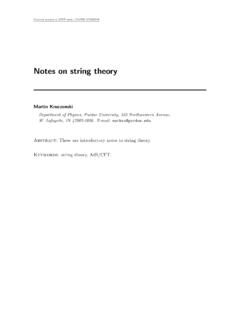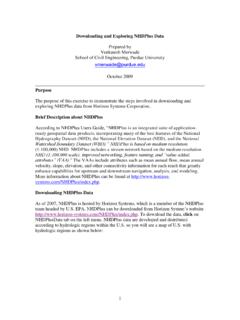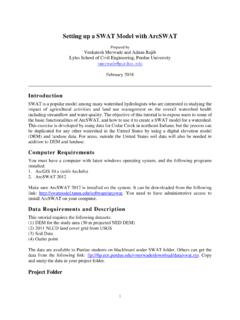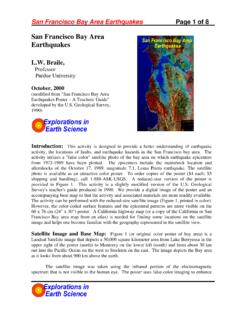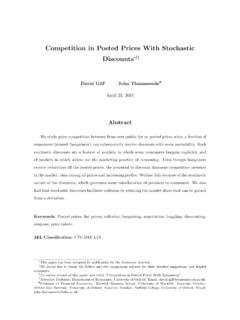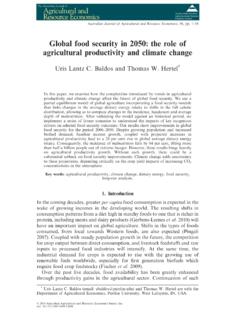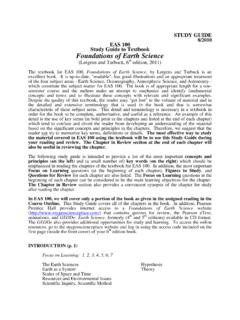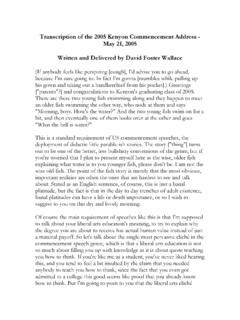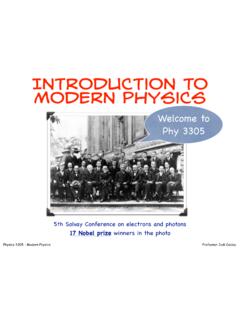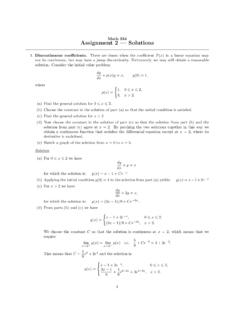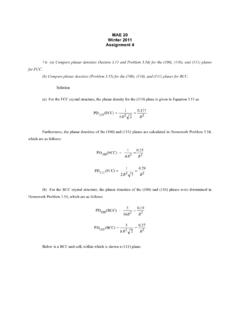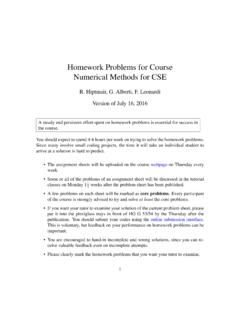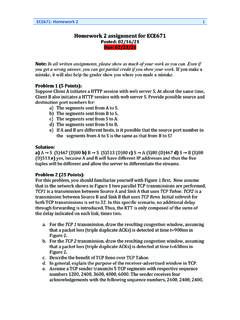Transcription of ECE 301: Signals and Systems Homework Assignment #3
1 ECE 301: Signals and SystemsHomework Assignment #3 Due on October 14, 2015 Professor:Aly El GamalTA:Xianglun Mao1 Aly El GamalECE 301: Signals and Systems Homework Assignment #3 Problem 1 Problem 1 Consider a causal LTI systemSwhose inputx[n] and outputy[n] are related by the difference equation2y[n] y[n 1] +y[n 3] =x[n] 5x[n 4].(a) Verify thatSmay be considered a cascade connection of two causal LTI systemsS1andS2with thefollowing input-output relationship:S1: 2y1[n] =x1[n] 5x1[n 4],S2:y2[n] =12y2[n 1] 12y2[n 3] +x2[n](b) Draw a block diagram representation ofS1.(c) Draw a block diagram representation ofS2.(d) Draw a block diagram representation ofSas a cascade connection of the block diagram representationofS1followed by the block diagram representation ofS2.(e) Draw a block diagram representation ofSas a cascade connection of the block diagram representationofS2followed by the block diagram representation ofS1.
2 (f) Show that the four delay elements in the block diagram representation ofSobtained in part (e) maybe collapsed to three. The resulting block diagram is referred to as aDirect Form IIrealization ofS,while the block diagrams obtained in parts (d) and (e) are referred to asDirect Form Irealizations (a) Realizing thatx2[n] =y1[n], we may eliminate these from the two given difference equations. Thiswould give us2y2[n] y2[n 1] +y2[n 3] =x1[n] 5x1[n 4].This is the same as the overall difference equation.(b) The figures corresponding to the remaining parts of this problem are shown in Figure 1 continued on next page..2 Aly El GamalECE 301: Signals and Systems Homework Assignment #3 Problem 1 (continued)Figure 1: The block diagram representations in sub-questions (b), (c), (d), (e), (f).3 Aly El GamalECE 301: Signals and Systems Homework Assignment #3 Problem 2 Problem 2 Determine the Fourier series representations for the following Signals .
3 You shall not only give the Fourierseries coefficients, but also give the Fourier series expression of the Signals .(a) Eachx[n] orx(t) illustrated in Figure 2.(b)x(t) periodic with period 2 andx(t) =e tfor 1 t 1.(c)x(t) periodic with period 4 andx(t) ={sin( t),0 t 2,0,2< t 2: The signal ofx[n] orx(t) in sub-question (a).Solution(a)(i) It is known thatN= 2. So thata0=1N Nx[n]e jk(2 /N)n=121 n=0x[n]e j 0 n=121 n=0x[n]= 12 Meanwhile,ak=1N Nx[n]e jk(2 /N)n=121 n=0x[n]e jk n=12 ( 1)kProblem 2 continued on next page..4 Aly El GamalECE 301: Signals and Systems Homework Assignment #3 Problem 2 (continued)The Fourier series representation isx[n] = k= akejk(2 /N)n= k= (12 ( 1)k)ejk n(ii) It is known thatT= 6. So thata0=1N Tx(t)e jk(2 /T)tdt=16 60x(t)e j 0 ( /3)tdt=16 60x(t)dt= 0 Meanwhile,ak=1T Tx(t)e jk(2 /T)tdt=16 60x(t)e jk( /3)tdt=16{ ( 21e jk( /3)tdt) + ( 54e jk( /3)tdt)}=1jk (cos(2k 3) cos(k 3))Note that not onlya0= 0, but alsoak even= Fourier series representation isx[n] = k= akejk(2 /T)t= k= (1jk (cos(2k 3) cos(k 3)))ejk( /3)t(k6= 0)(b) It is known thatT= 2.}
4 So thatak=1T Tx(t)e jk(2 /T)tdt=12 1 1e te jk tdt=12 1 1e( jk 1)tdt=12(1 +jk )[e1+j k e 1 j k]for Fourier series representation isx[n] = k= akejk(2 /T)t= k= (12(1 +jk )[e1+j k e 1 j k])ejk tProblem 2 continued on next page..5 Aly El GamalECE 301: Signals and Systems Homework Assignment #3 Problem 2 (continued)(c) It is known thatT= 4. So thata0=1T Tx(t)e jk2 /Ttdt=14 20sin( t)e j 0 (2 /4)tdt=14 20sin( t)dt= 0ak=1T Tx(t)e jk2 /Ttdt=14 20sin( t)e jk( /2)tdt=18j 20(ej t e j t)e jk( /2)tdt=18j[ej (2 k) 1j (1 k/2)+ej (2+k) 1j (1 +k/2)]=e j k (k2 4)=( 1)k (k2 4)The Fourier series representation isx[n] = k= akejk(2 /T)t= k= (( 1)k (k2 4))ejk( /2)t(k6= 0)6 Aly El GamalECE 301: Signals and Systems Homework Assignment #3 Problem 3 Problem 3 Consider the following three continuous-time Signals with a fundamental period ofT= 1/2:x(t) =cos(4 t),y(t) =sin(4 t),z(t) =x(t)y(t).(a) Determine the Fourier series coefficients ofx(t).
5 (b) Determine the Fourier series coefficients ofy(t).(c) Use the results of parts (a) and (b), along with themultiplicationproperty of the continuous-timeFourier series, to determine the Fourier series coefficients ofz(t) =x(t)y(t).(d) Determine the Fourier series coefficients ofz(t) through direct expansion ofz(t) in trigonometric form,and compare your result with that of part(c).Note that you shall only give the nonzero Fourier series coefficients as (a)x(t) =cos(4 t) =12e4 t+12e 4 tSo that the nonzero FS coefficients ofx(t) area1=a 1= 1/2.(b)y(t) =sin(4 t) =12je4 t 12je 4 tSo that the nonzero FS coefficients ofx(t) areb1= 1/2j,b 1= 1/2j.(c) Using themultiplicationproperty, we know thatz(t) =x(t)y(t)FS ck= t= albk lTherefore,ck=ak bk= t= albk l=14j [k 2] 14j [k+ 2]This implies that the nonzero Fourier series coefficients ofz(t) arec2=14j,c 2= 14j.(d) We havez(t) =sin(4t)cos(4t) =12sin(8t) =14je8 t 14je 8 tTherefore, the nonzero Fourier series coefficients ofz(t) arec2=14j,c 2= 14j, the same with part(c).
6 7 Aly El GamalECE 301: Signals and Systems Homework Assignment #3 Problem 4 Problem 4 Letx(t) be a periodic signal whose Fourier series coefficients areak={2,k= 0j(12)|k|,otherwiseKnown that the period of signalx(t) isT, use the Fourier series properties to answer the following questions:(a) Isx(t) real?(b) Isx(t) even?(c) Isdx(t)dteven?Solution(a) Ifx(t) is real, thenx(t) =x (t). This implies that forx(t),ak=a k. Since this is not true in thiscase, for example,a1=j(12)6= j(12) =a ,x(t) is not real.(b) Ifx(t) is even, thenx(t) =x( t). This implies that forx(t),ak=a k. Since this is true in this case,because,ak=j(12)|k|=j(12)|k|=a ,x(t) is even.(c) We haveg(t) =dx(t)dtFS bk=jk2 Tak,whereTrefer to the period of signalx(t). Therefore,bk={0,k= 0 k(1/2)|k|(2 /T),otherwiseSincebkis not even,g(t) is not El GamalECE 301: Signals and Systems Homework Assignment #3 Problem 5 Problem 5 Letx[n] ={1,0 n 70,8 n 9be a periodic signal with fundamental periodN= 10 and Fourier series coefficientsak.}}}
7 Also, letg[n] =x[n] x[n 1].(a) Draw the graph of signalg[n], and determine the fundamental period ofg[n].(b) Determine the Fourier series coefficients ofg[n].(c) Using the Fourier series coefficients ofg[n] and the First-Difference property, determineakfork6= (a) For 0 n 9, We haveg[n] =x[n] x[n 1] = 1, n= 00,1 n 7 1, n= 80, n= 9 This period begin to show again in the following 10 points, it s clearly to draw the conclusion thatg[n]is periodic with period of 10. The graph of signalg[n] is shown in Figure 3: The graph of signalg[n].(b) It is known thatT= 10. So that the FS coefficients ofg[n] isbk, which isbk=1N Ng[n]e jk(2 /N)n=1109 n=0g[n]e jk( /5)n=110(1 e j8k( /5))(c) Sinceg[n] =x[n] x[n 1], the FS coefficientsakandbkmust be related asbk=ak e jk( /5) ,ak=bk1 e jk( /5)=1101 e j8k( /5)1 e jk( /5)9
